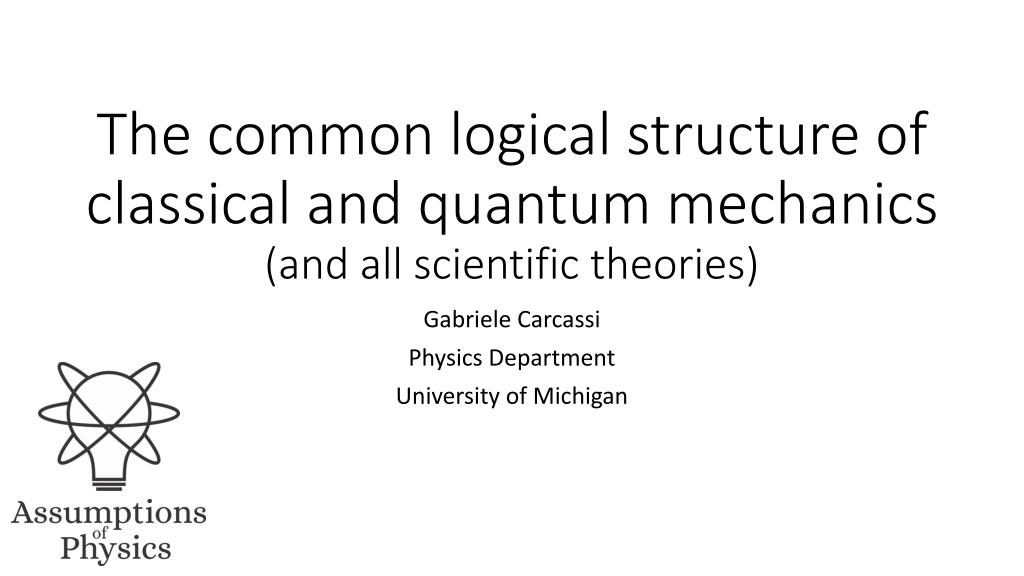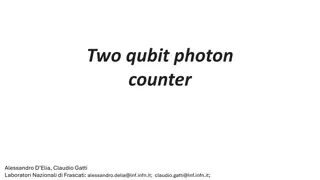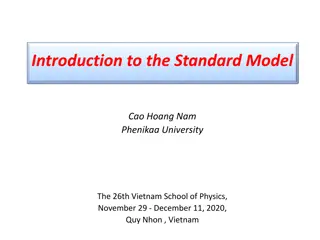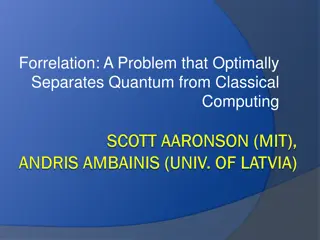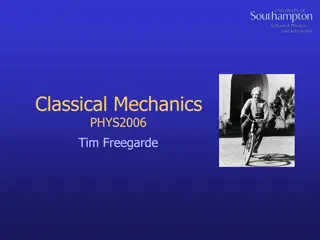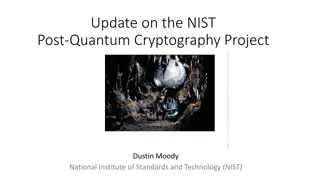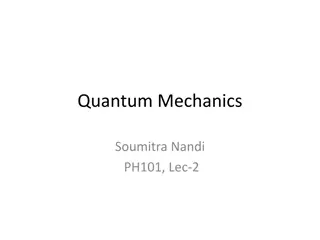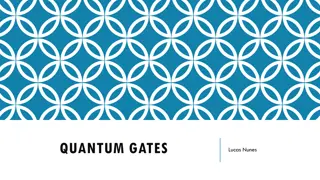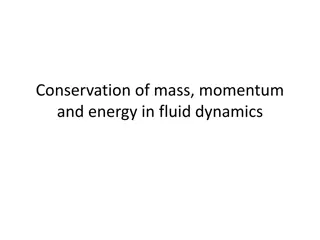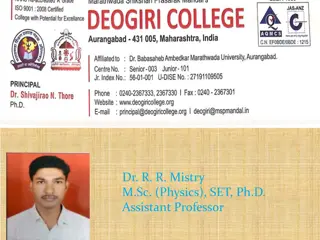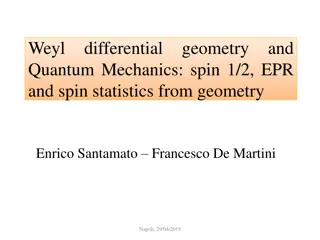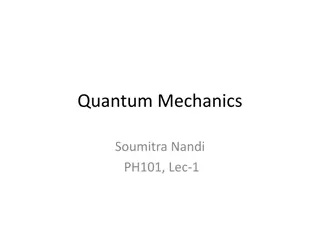The Logical Structure of Classical and Quantum Mechanics
The paper explores the common logical structure shared between classical and quantum mechanics, emphasizing the non-distributive lattice embedded in a distributive one. It discusses how all physical theories must adhere to this structure, incorporating topology, Heyting algebra, Boolean algebra, and statistical mixing. The comparison between classical and quantum mechanics reveals similarities in their logical frameworks, highlighting the importance of experimental verification and the identification of verifiable and theoretical statements within a scientific theory.
Download Presentation

Please find below an Image/Link to download the presentation.
The content on the website is provided AS IS for your information and personal use only. It may not be sold, licensed, or shared on other websites without obtaining consent from the author. Download presentation by click this link. If you encounter any issues during the download, it is possible that the publisher has removed the file from their server.
E N D
Presentation Transcript
The common logical structure of classical and quantum mechanics (and all scientific theories) Gabriele Carcassi Physics Department University of Michigan
The paper The common logical structure of classical and quantum mechanics Andrea Oldofredi, Gabriele Carcassi, Christine A. Aidala Erkenntnis (2022) Andrea Oldofredi Gabriele Carcassi Christine A. Aidala University of Lisbon University of Michigan Gabriele Carcassi - Physics Department - University of Michigan 2
Project website: https://assumptionsofphysics.org/ YouTube channel: https://www.youtube.com/user/gcarcassi Facebook page: https://www.facebook.com/AssumptionsOfPhysics Main goal: to identify a handful of physical principles from which the basic laws can be rigorously derived Sub-goal: a sturdier mathematical foundation for physical theories (all mathematical definitions justified from physical requirements) Gabriele Carcassi - Physics Department - University of Michigan 3
Thesis When the proper comparison is set up, classical and quantum mechanics follow the same logical structure Both theories have a non-distributive lattice embedded in a distributive one More in general: all physical theories must follow the same logical structure Topology (Open sets) Heyting algebra of experimentally verifiable statements ?-algebra (Borel sets) Boolean algebra of statements associated with a test Statistical mixing Non-distributive lattice of closed subspaces Gabriele Carcassi - Physics Department - University of Michigan 4
Plan Supposed failures of classical logic Distributive law and conjunction (logical OR) in QM; the role of temporal evaluation and statistical considerations in showing how quantum mechanics obeys classical logic Common logical structure of CM and QM The lattice of quantum logic (closed subspaces) does not contain all physically relevant statements; QM already has a classical lattice of statements (?-algebra) which does; if we compare to a classical statistical theory, the situation is the same (lattice of closed sub- spaces embedded in ?-algebra) General logical structure for all scientific theories Requirements from experimental verification: statements verifiable in finite time, countable at maximum; the lattice of verifiable statements identifies a topology; the lattice of theoretical statements identifies a ?-algebra; any theory that allows statistical mixing will also provide lattice of closed subspaces Gabriele Carcassi - Physics Department - University of Michigan 5
Disclaimer Andrea Oldofredi is the one fluent in the philosophical and quantum logic literature My interest and expertise lies in understanding how the details of the mathematical structure map to physical concepts Gabriele Carcassi - Physics Department - University of Michigan 6
Supposed failures of classical logic Gabriele Carcassi - Physics Department - University of Michigan 7
? ? ? ? ? (? ?) Distributivity law Consider the following statements ? the electron has x-spin up ? the electron has y-spin up ? the electron has y-spin down Claim: spin in the y direction is either up or down ? ? = Claim: x and y directions are incompatible ? ? = ? ? = Distributivity violated! Suppose ? = ? ? ? = ? ? ? ? = Gabriele Carcassi - Physics Department - University of Michigan 8
? ? = if and only if ? = or ? = Disjunction Claim: spin in the y direction is either up or down ? ? = Claim: this is true even if we prepare x-spin up But if ? = , then ? = ? = even though ? ? = Quantum disjunction works differently! Gabriele Carcassi - Physics Department - University of Michigan 9
? ? ? ? ? (? ?) Distributivity law Analog scenarios can be constructed with classical systems p A ball can be placed in position p, above a hatch; when the hatch is open, the ball will land in either position q or r with equal probability (due to the symmetry) q r We can make similar misleading claims the ball must land either on q or r: ? ? = the ball cannot be in two places at once: ? ? = ? ? = Classical mechanics does not follow classical logic! Gabriele Carcassi - Physics Department - University of Michigan 10
? ? ? ? ? (? ?) Distributivity law Need to take into account time: use ? for preparation (input) and ? for measurement (output) The spin in the y direction is either up or down after a y measurement: ?? ??= There is no incompatibility between x direction before the measurement and y direction after the measurement: ?? ??= if we prepared x-up and measured y-up Distributivity not violated! Gabriele Carcassi - Physics Department - University of Michigan 11
? ? = if and only if ? = or ? = Disjunction Yes, if we measure y, we either have y-spin up or y-spin down Suppose you rotate y-spin down after the measurement: ?? ??= It does not follow that we must always have x-spin up or y-spin up: ?? ??= ?? ??= and ?? ??= ?? ??= So, how does the quantum disjunction work? Gabriele Carcassi - Physics Department - University of Michigan 12
? ? = if and only if ? = or ? = Disjunction Since we have no idea how the disjunction in QM should work, let s find equivalent statements for which we know how the disjunction works! ? the electron has y-spin up ? the expectation of y-spin is /2 ? the electron has y-spin down ? the expectation of y-spin is /2 Because those are extremal values, the statements are equivalent: ? ? and ? ? ? ? the expectation of y-spin is /2 This is not always true! True and only true if y-spin is up or down! Quantum disjunction works the same! Gabriele Carcassi - Physics Department - University of Michigan 13
? ? = if and only if ? = or ? = Disjunction ? /4 ? the state of the particle is in A ? the state of the particle is in B A B Claim: the statement ? ? can be true but, because of the uncertainty principle, ? = ? = ? Quantum disjunction works differently! Gabriele Carcassi - Physics Department - University of Michigan 14
? ? = if and only if ? = or ? = Disjunction ? Either statistical or probabilistic Consider a classical distribution ? ?,? /4 Ambiguous ? the state of the particle is in A A B ?? the center of mass is in A ?? one stdev of the distr. is in A ?, ? ? ? ??/2, ? + ??/2 ? ??/2, ? + ??/2 ? ? ?? ?? one stdev of the distr. is in A B Half-sigma in A and half-sigma in B ?? ??= the center of mass is in A B The disjunction does not always map to the union of the region (nothing to do with quantum mechanics) Gabriele Carcassi - Physics Department - University of Michigan 15
? ? = if and only if ? = or ? = Disjunction ? For a quantum state ? /4 Ambiguous ? the state of the particle is in A A B ?? the center of mass is in A ?? one stdev of the distr. is in A ?, ? ? ? ??/2, ? + ??/2 ? ??/2, ? + ??/2 ? ? ?? ?? one stdev of the distr. is in A B ?? ??= the center of mass is in A B Half-sigma in A and half-sigma in B Quantum disjunction works the same! (just map to quantum expectations) Gabriele Carcassi - Physics Department - University of Michigan 16
How to not get confused Be explicit on the process and the temporal ordering What processes (e.g. preparations and measurements) is the system subjected to? When are the statements evaluated? Be explicit about statistical/probabilistic attributes Are we discussing center of mass (always well defined), support, standard deviation, ? When comparing classical and quantum mechanics, compare apples to apples (i.e. expectation values with expectation values) and oranges to oranges (i.e. support/stdDev with support/stdDev) Gabriele Carcassi - Physics Department - University of Michigan 17
Common logical structure of CM and QM Gabriele Carcassi - Physics Department - University of Michigan 18
Link between logic and set theory Consider various scientific statements such as: the mass of the electron is within 500 50keV the earth-moon distance is 400,000 km 50,000km there are 6 flavors of quarks Statement Subset The object we are describing They can be modelled mathematically with the following pattern: The set all possible ways the object can be ? ? ? A subset of possible ways the object can be Gabriele Carcassi - Physics Department - University of Michigan 19
Link between logic and probability theory A probability space is a triple , ,? Sample space the set of all possible outcomes ({1,2,3,4,5,6} for a die) A ?-algebra collection of all events we consider (even, odd, less than 3, ) A probability measure ? assigns a probability to each event Mathematically, a ?-algebra is a collection of subsets closed under complement, countable union and countable intersection is countably complete Boolean algebra of statements Probability theory requires classical logic Gabriele Carcassi - Physics Department - University of Michigan 20
Do Hilbert spaces have a ?-algebra? Yes Hilbert space normed vector space metric space topological space equipped with a Borel ?-algebra Is the Borel ?-algebra something intelligible?Yes A metric space defines a distance. A distance allows us to write statements of the type: ? ?,? = "? ?,?2< ?2" The object ? is within ? of reference ? Any element in the ?-algebra is constructed from statements of that type using countable disjunction/conjunction and negation Gabriele Carcassi - Physics Department - University of Michigan 21
What is the relationship with quantum logic? The statements of quantum logic correspond to the closed subspaces of the Hilbert space. The ?-algebra contains all closed subsets. The lattice of quantum logic is a proper subset of the ?-algebra QL Gabriele Carcassi - Physics Department - University of Michigan 22
Are the extra statements physically useful? Yes Statements of the type the expectation of observable ? is within ? are part of but not QL The expectation of ? given ? is given by ? ? ? = ? ?? , which is continuous if ? is bounded. This means the pre-image of Borel sets are Borel sets. E.g.: the average z-spin is zero Not closed subspace Plenty of physically meaningful statements!!! QL Gabriele Carcassi - Physics Department - University of Michigan 23
Quantum mechanics Classical mechanics - ?(?) - ?(?,?) Metric induced topology T Metric induced topology T Countably complete Boolean algebra of statements Countably complete Boolean algebra of statements Non-distributive lattice of closed subspaces ?( ) Non-distributive lattice of closed subspaces ?( ) Gabriele Carcassi - Physics Department - University of Michigan 24
To summarize Probability theory requires a countably complete Boolean (classical) lattice of statements Quantum mechanics comes already equipped with such a lattice of statements (the Borel algebra) The Borel algebra includes all QL statements (everything QL does can be done in the Borel algebra) The Borel algebra includes statistical statements, which are of physical interest, that are not part of the QL statements (QL does not allow us to capture all physical statements) The same structure exists for classical distributions over phase-space Quantum mechanics and classical mechanics, when properly compared, share a common logical structure The measure theoretic structure, however, will be different Gabriele Carcassi - Physics Department - University of Michigan 25
Common logical structure of all scientific theories Gabriele Carcassi - Physics Department - University of Michigan 26
We want to capture the scientific requirement of experimental verification. The basic notion will be verifiable statements: assertions that can be experimentally verified in a finite time Counterexamples: The mass of the photon is exactly 0 eV (not verifiable due to infinite precision) There is no extra-terrestrial life (absence of evidence is not evidence of absence) Examples: The mass of the photon is less than 10 13 eV If the height of the mercury column is between 24 and 25 millimeters then its temperature is between 24 and 25 Celsius If I take 2 0.01 Kg of Sodium-24 and wait 15 0.01 hours there will be only 1 0.01 Kg left We have to keep in mind that the meaning of the statements, their relationships and what truth values are allowed depends on context (e.g. premise, theory, etc ) The mass of the electron is 511 0.5 KeV When measuring the mass, it is a verifiable hypothesis When performing particle identification, it is assumed to be true Gabriele Carcassi - University of Michigan 27
Properties of verifiable statements ? ?1 Test Result ?v SUCCESS (in finite time) T FAILURE (in finite time) F UNDEFINED ?1 experimental test ? ?1 ?2 ?3 ?? ?=? All tests must succeed ?1 ?2 ?3 ?? ?=1 One successful test is sufficient Gabriele Carcassi - University of Michigan 28
Requirements of experimental verifiability: 1. Verifiable statements are closed under finite conjunction and countable disjunction. 2. We can at most verify countably many statements (in the limit of arbitrarily long time). Experimental domain ??: a set of verifiable statements 1. closed under finite conjunction and countable disjunction 2. generated by countably many verifiable statements Theoretical domain ?? ??: all statements with a test, regardless of termination (closure of an experimental domain under negation and countable conjunction/disjunction) Possibilities ? ??: the statements that give the complete picture (i.e. every theoretical statement ?, they either imply ? or ? mathematically, the atoms of the lattice ??) Gabriele Carcassi - Physics Department - University of Michigan 29
Experimentally distinguishable cases Statements formally associated with an experimental test Theoretical statements Precise map between physical concepts and their mathematical representation Verifiable statements If true, test always succeeds in finite time Possibilities ?-algebra Borel sets All proofs can be translated into physically meaningful Points Open sets Topology language Gabriele Carcassi - Physics Department - University of Michigan 30
Some interesting results Every set of physically distinguishable cases is a T0 second-countable topological space Every set of physically distinguishable cases can have up to the cardinality of the continuum Every relationship between two sets of physically distinguishable cases must be topologically continuous, as inference can be used for experimental verification Every relationship between two real quantities must be analytically continuous with up to countably many discontinuities, and the region of those discontinuities must be verifiable (e.g. we can verify water is in the triple point or undergoing phase transition) We identified a set of necessary and sufficient physical conditions that lead to ordered quantities (these cannot be assumed valid at Planck scale) These are general results that must be valid for all theories Gabriele Carcassi - Physics Department - University of Michigan 31
Space of the well-posed scientific theories Physical theories Specializations of the general theory under the different assumptions Unitary evolution Hamiltonian mechanics Quantum state-space Classical phase-space Infinitesimal reducibility Determinism/ reversibility Assumptions Irreducibility States and processes General theory Informational granularity Basic requirements and definitions valid in all theories Experimental verifiability C. A. Aidala - G. Carcassi - University of Michigan 32
We want to describe the space of states for a system Set of physically distinguishable elements verifiable theoretical statements Topology ( ) and ?-algebra ( ) statements Must allow for ensembles ????+ ???? Statistical mixture imposes a linear operation Lattice of subspaces Gabriele Carcassi - Physics Department - University of Michigan 33
Conclusions Once the full meaning of quantum propositions is properly taken into account, quantum mechanics follows classical logic Quantum logic propositions only apply to single-shot measurements, and therefore are of very limited use Hilbert spaces are already equipped with a classical logic lattice (the ?-algebra) that includes all quantum logic statements plus all statistical statements The space of classical statistical distributions is also a Hilbert space, which is equipped with a similar quantum logic lattice This pattern stems from a requirement of experimental verification, and therefore is common to all physical theories Topology (Open sets) Heyting algebra of experimentally verifiable statements ?-algebra (Borel sets) Boolean algebra of statements associated with a test Statistical mixing Non-distributive lattice of closed subspaces Gabriele Carcassi - Physics Department - University of Michigan 34
Resources Project website: https://assumptionsofphysics.org/ Papers, presentation slides, list of open problems, YouTube channel: https://www.youtube.com/user/gcarcassi Popularize results of our research, recorded presentations, Reverse physics: from laws to physical assumptions https://arxiv.org/abs/2111.09107 (Foundations of Physics 2022) Geometrical and physical interpretation of the action principle https://arxiv.org/abs/2208.06428 (pre-print) The four postulates of quantum mechanics are three https://arxiv.org/abs/2003.11007 (Physical Review Letters 2021) Facebook page https://www.facebook.com/AssumptionsOfPhysics Gabriele Carcassi - Physics Department - University of Michigan 35
Gabriele Carcassi - Physics Department - University of Michigan 36
